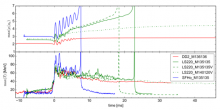
Abstract
Matter in neutron star collisions can reach densities up to few times the nuclear saturation threshold and temperatures up to one hundred MeV. Understanding the structure and composition of such matter requires many-body nonperturbative calculations that are currently highly uncertain.Unique constraints on the neutron star matter are provided by gravitational-wave observations aided by numerical relativity simulations. In this work, we explore the thermodynamical conditions of matter and radiation along the merger dynamics. We consider 3 microphysical equation of state models and numerical relativity simulations including an approximate neutrino transport scheme. The neutron star cores collision and their multiple centrifugal bounces heat the initially cold matter to several tens of MeV. Streams of hot matter with initial densities ∼1−2ρ0 move outwards and cool due to decompression and neutrino emission. The merger can result in a neutron star remnant with densities up to 3−5ρ0 and temperatures ∼50~MeV. The highest temperatures are confined in an approximately spherical annulus at densities ∼ρ0. Such temperatures favour positron-neutron capture at densities ∼ρ0, thus leading to a neutrino emission dominated by electron antineutrinos. We study the impact of trapped neutrinos on the remnant matter's pressure, electron fraction and temperature and find that it has a negligible effect. Disks around neutron star or black hole remnant are neutron rich and not isentropic, but they differ in size, entropy and lepton fraction depending on the nature of the central object. In presence of a black hole, disks are smaller and mostly transparent to neutrinos; in presence of a massive neutron star, they are more massive, geometrically and optically thick.